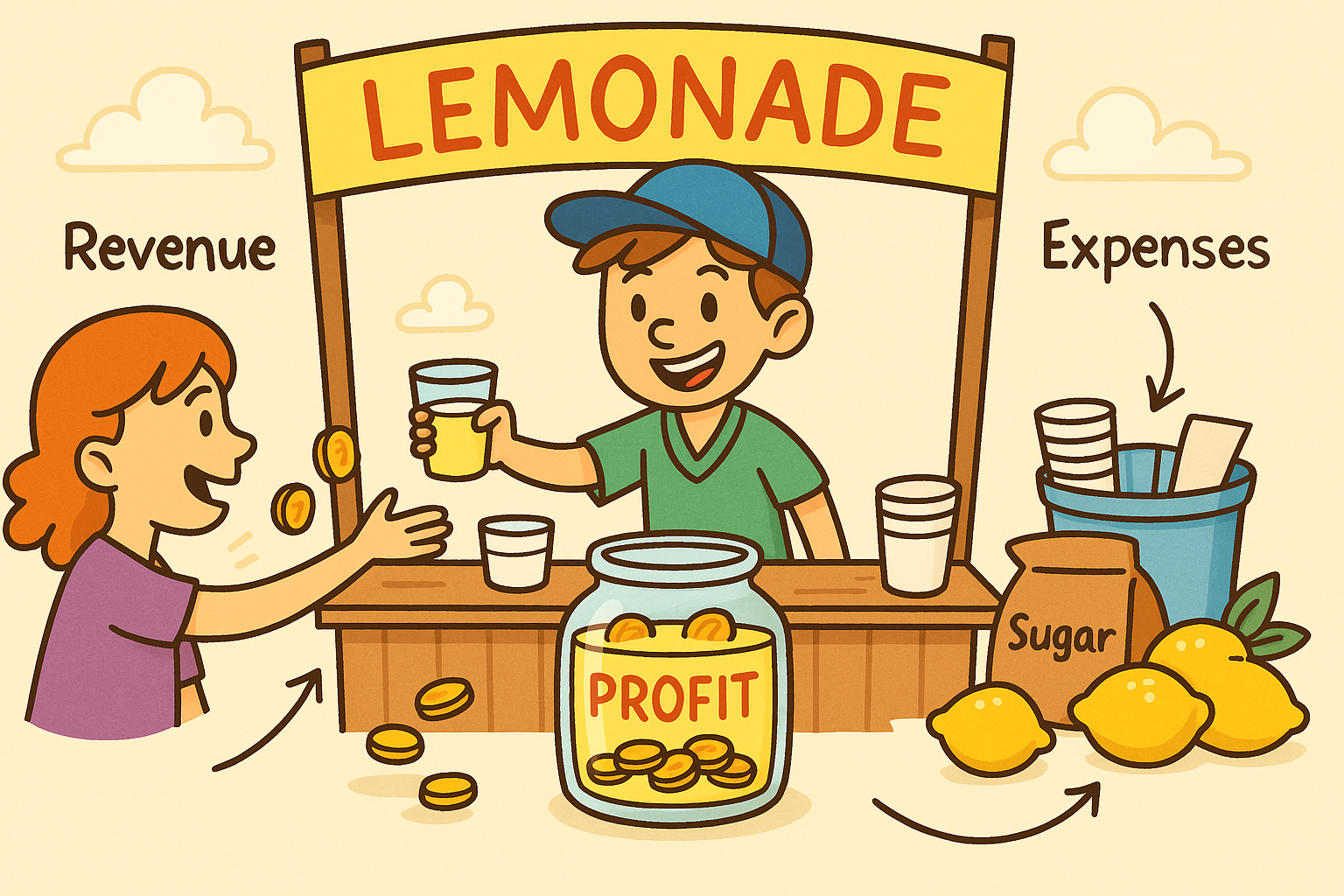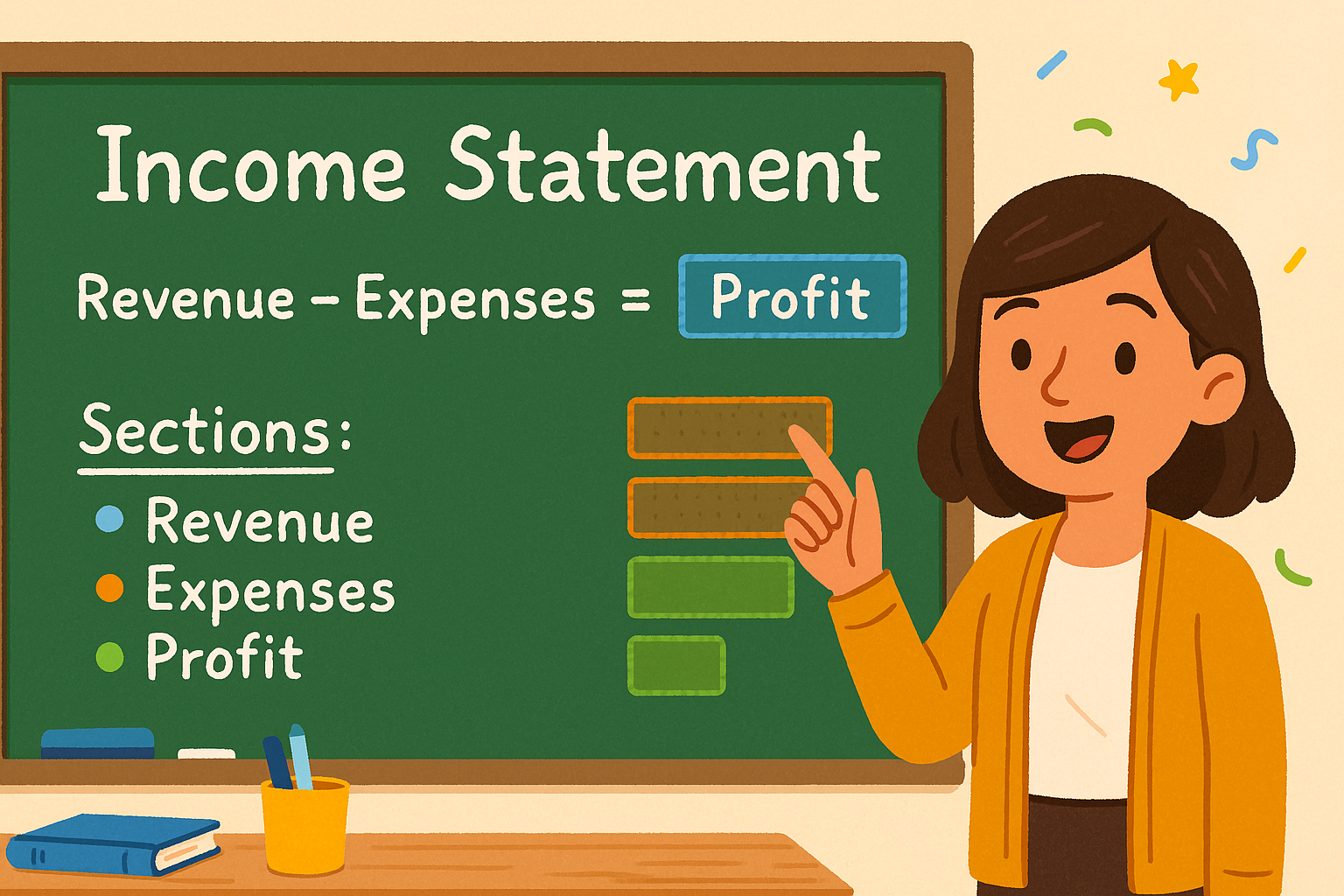📈 Income Statement for Beginners
Welcome to one of the most important tools in business — the Income Statement, also known as the Profit and Loss (P&L) report.
If the balance sheet is a photo, then the income statement is a movie — it shows what happened over time:
How much you earned, how much you spent, and whether you made a profit or a loss.
🎬 The Main Idea
Every business exists to create value — and value shows up as income.
But running a business costs money — that’s your expenses.
The difference between the two is profit (or loss, if you spent more than you earned).
💡 Formula:
Profit = Revenue – Expenses
Simple, yet incredibly powerful.
It tells you whether your effort is paying off.
🍋 Example: The Lemonade Stand
Let’s say you run a small lemonade stand for one week.
| Item | Amount ($) |
|---|---|
| Lemon sales | 100 |
| Sugar & lemons | 30 |
| Cups | 10 |
| Poster & stand materials | 10 |
| Profit | 50 |
You made $100 in revenue but spent $50 on supplies.
That leaves you with $50 profit — your reward for the work.

The lemonade stand example — every sale brings in revenue, every purchase creates expenses, and what’s left in the jar is profit.
🏢 Real Business Example
Now imagine a small café.
Every month, it earns money from customers and spends on ingredients, rent, and salaries.
| Category | Amount ($) |
|---|---|
| Revenue (Sales) | 12,000 |
| Cost of Goods Sold (ingredients, coffee) | 4,000 |
| Rent | 2,000 |
| Staff Salaries | 3,000 |
| Marketing | 500 |
| Utilities & Other | 500 |
| Total Expenses | 10,000 |
| Net Profit | 2,000 |
The café made a profit — not just because sales were high, but because they managed expenses wisely.
If rent or salaries rise too fast, profit shrinks.
If sales increase while costs stay stable — profit grows.
That’s the dance every business tries to master.
⚖️ Three Layers of the Income Statement
The P&L is often divided into three levels — like climbing a mountain:
- Gross Profit – what’s left after you subtract the cost of goods (materials, ingredients, packaging).
- Operating Profit – after removing all business costs (rent, salaries, marketing).
- Net Profit – what’s truly yours after taxes and interest.
Example:
| Stage | Formula | Example |
|---|---|---|
| Gross Profit | Sales – Cost of Goods | 12,000 – 4,000 = 8,000 |
| Operating Profit | Gross – Operating Expenses | 8,000 – 6,000 = 2,000 |
| Net Profit | After taxes & extras | 2,000 – 0 = 2,000 |
Each layer tells a different story — are you producing efficiently, operating efficiently, and keeping enough of what you earn?

The income statement layers — from revenue to expenses to profit — showing how each part builds the story of business performance.
🧠 Why It Matters
The income statement shows the truth about performance.
- Are you earning more than you spend?
- Which part of your business eats most money?
- How much can you reinvest or save?
Entrepreneurs use it to spot problems early:
too many expenses → shrink marketing or change suppliers.
steady profit → time to grow or hire.
Even at a personal level, this is powerful.
Your own “income statement” might include your allowance or salary (income) and your daily costs (expenses).
If you track it, you’ll instantly see where your money really goes.
🧩 Try It Yourself
- Take your last 7 days of spending.
- Add all the money you received (income).
- Subtract your total expenses.
- The number left — that’s your personal profit or loss!
Repeat this monthly and you’ll start thinking like a business owner.
🌍 Real-World Tip
Public companies (like Apple or Netflix) publish their income statements every quarter.
Analysts, journalists, and investors study them to see trends — is profit growing, are costs under control, is the company healthy?
You can read them too! They’re public on investor websites.
💬 Remember:
A profitable business is one that turns its ideas into value — efficiently and consistently.
The next step is learning when money moves, not just how much — that’s what Cash Flow is all about.
📝 Try this today
List your 3 sources of income and 3 regular expenses.
Create a simple P&L table: Income – Expenses = Profit.
Find a real company’s income statement online and spot its biggest cost.
Lesson Progress
Module: accounting · +0% upon completion